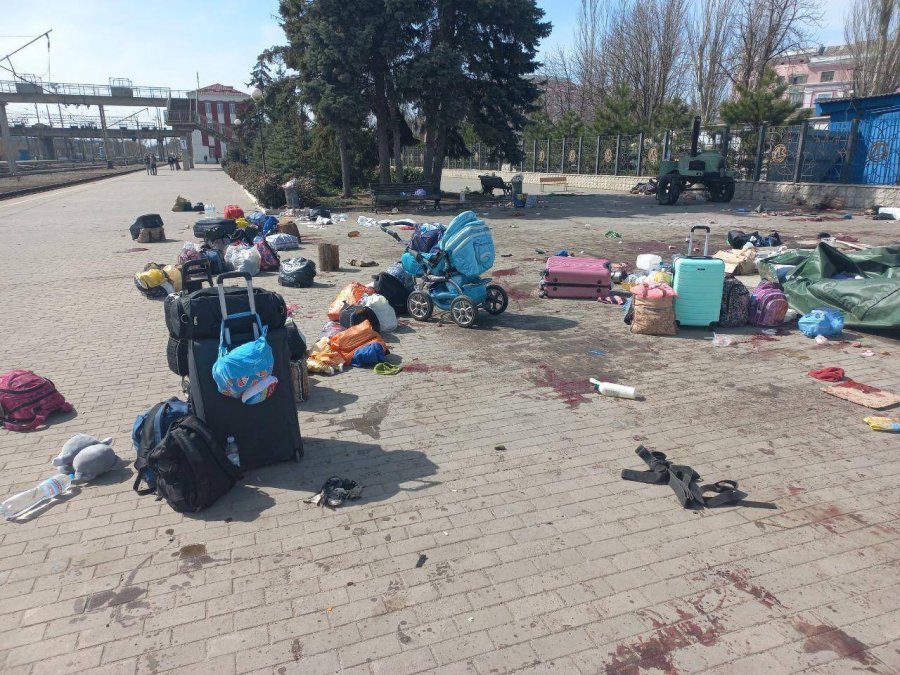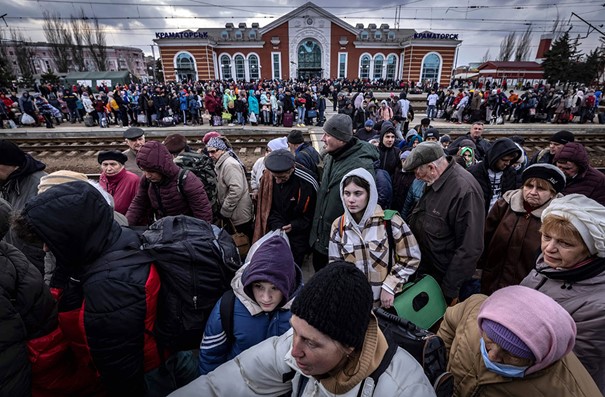Russia used prohibited cluster munitions for horrific attack on Kramatorsk Railway Station

Russia’s attack on the Kramatorsk Railway Station on 8 April 2022 was “a violation of the laws of war and an apparent war crime”, Human Rights Watch has concluded as the result of an investigation carried out in cooperation with SITU Research. Although the same paragraph only speaks of Russia’s culpability being “strongly indicated”, the entire report leaves no scope for doubt about this. There was also no possibility that Russia did not know that it would be killing civilians trying to flee its invasion when it attacked a train station. .
Nothing in the report is strictly new. The Governor of the Donetsk oblast, Pavlo Kyrylenko, Governor of the Donetsk oblast, stated clearly on the day of the attack, that Russia had used cluster munitions and pointed to the fact that Russia had previously bombed railway tracks to disrupt evacuation, but had now turned to targeting civilians.

The attack on Kramatorsk Railway Station came the following day after a Russian airstrike bombed railway tracks near Barvenkove Station, with this blocking the route by which three trains were due to evacuate civilians from Kramatorsk, Sloviansk and Lyman. Kyrylenko reported very late in the evening on 7 April that the tracks had been repaired and that the trains would continue their evacuation. It was less than 12 hours later, on 10.28 on 8 April that, according to the new report, “a ballistic missile equipped with a cluster munition warhead dispersed 50 small bombs, known as submunitions, over the train tracks and station in Kramatorsk” The human rights NGO has studied a huge number of photos, as well as video footage, and believes there to have been around 500 people at the station. “At least 58 people were killed – all of them to our knowledge civilians – and over 100 others were injured.”
It is worth noting that many Russian Telegram channels, including Siloviki.ru, immediately reported, citing “our sources in Kramatorsk”, a strike in the area of the railway station. The reports essentially boasted of the strike which was claimed to have targeted military equipment and ammunitions which the Ukrainian Armed Forces had purportedly brought to the station.
HRW details the official Russian government claims which began two hours after the missile strike. The Russian defence ministry initially denied any strike and “falsely stated that only Ukrainian forces use the Tochka-U”. Later that day, the same ministry claimed that Ukrainian forces had carried out the attack to disrupt the evacuations and use civilians as human shields. HRW dismisses all such denials and points to the enormous evidence that the Ukrainian authorities were doing everything to evacuate civilians. HRW notes that Russian foreign minister Sergei Lavrov came out with similar claims on 20 April 2022 and states clearly: “Human Rights Watch found no evidence to support these Russian claims. On the contrary, all evidence points to Russian forces having fired the Tochka-U missile with cluster munitions on the Kramatorsk train station.”
Despite Russian denials, it is clear that the weapon used was a 9M79K-1 ballistic missile, or Tochka-U, probably launched from near the village of Kunie in the Kharkiv oblast. HRW notes that this weapon “is designed to cause maximum destructive effect.”
The report also notes the words found on the side of the missile’s rocket motor: ‘За детей”. This is literally ‘for the children’, but HRW uses the translation ‘payback for the children’. A useful account is provided for how the slogan ‘Payback for the children of Donbas” has been used in Russia and Russian-occupied territories as a rallying cry. Although the report mentions only this use, it should be noted that, like Russia’s claims about the tragedy in Odesa on 2 May 2014, or its allegations of ‘Ukrainian genocide of the Russian-speaking population of Donbas”, this is a slogan which does not withstand critical analysis.
Human Rights Watch points out that the laws of war (the Geneva Conventions of 1949; the First Additional Protocol to the Geneva Conventions and customary international law) prohibit deliberate attacks on civilians and civilian objects, attacks that cannot discriminate between combatants and civilians, and attacks that could be expected to cause disproportionate civilian harm compared to any concrete military gain.
It concludes that “Russia’s attack on the crowded Kramatorsk train station was unlawfully indiscriminate. Railroad tracks and train stations are used by armed forces for military purposes and therefore can be lawful military targets. However, Human Rights Watch found no evidence that the Kramatorsk station was at the time of the attack being used for military purposes or that there were Ukrainian forces in the area.”
Although the NGO found “some evidence of possible minimal military use of the station and nearby rail network at the time of the attack”, the attack on the Kramatorsk station would, in any case, have been “unlawfully disproportionate”. “Bombing a train station in the morning when it was crowded with civilian passengers, families, and station workers, rather than late at night when it would have been far less crowded, demonstrates a disregard for civilian life.“
The attack should also be viewed as indiscriminate because of the weapon used. “Although neither Russia nor Ukraine are parties to the 2008 Convention on Cluster Munitions, which bans these weapons, their use is widely considered to be a violation of international humanitarian law because they cannot discriminate between combatants and civilians, and because of the long-lasting danger to civilians from unexploded submunitions.”
“The unlawful nature of the Kramatorsk attack, the evidence of a large civilian presence without a significant military objective, and the use of an inherently indiscriminate weapon indicate that the Russian military commanders and personnel who ordered and carried out the attack were committing a war crime.”
Russia did not answer questions put to it by HRW. It has systematically blocked any investigation of the explosion which killed well over 50 Ukrainian prisoners of war at a notorious ‘concentration camp’ near Olenivka in occupied Donetsk oblast. In occupied Mariupol, it is destroying the evidence of its most heinous crimes (such as the bombing of the Drama Theatre, killing at least 300 civilians who were seeking shelter) and using forcibly deported Ukrainian civilians or tortured POWs to obtain false testimony blaming its crimes on Ukraine’s Armed Forces. All of this makes the evidence that organizations like HRW and SITU Research has gathered invaluable.
It does, however, need to be used for a war crimes tribunal now.





